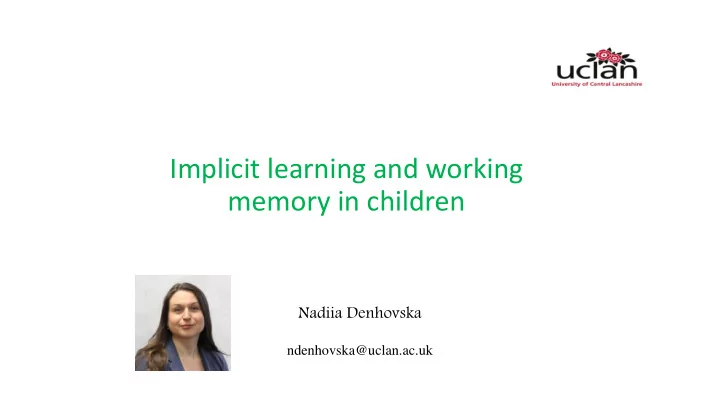

Implicit learning and working memory in children Nadiia Denhovska ndenhovska@uclan.ac.uk
Implicit Learning • Implicit learning is learning without awareness about the regularities governing the material • Leads to knowledge which it is difficult or impossible to access consciously and/or to report verbally (Reber, 1993) • Important for the acquisition of many skills • First & second language (Kidd, 2012; Saffran et al., 1996) • Reading and writing (Gombert, 2003) • Social skills
How Children Learn • Children learn implicitly • Development of explicit knowledge
Development of Implicit Learning Abilities • Develop in infancy/early childhood and remain stable throughout the lifespan (Gomez & Gerken, 1999; Meulemans, Van der Linden, & Perruchet, 1998; Reber, 1993) • Independent of age (Vinter & Perruchet, 2000) • Independent of IQ • Some evidence in support of developmental change • Adults outperformed children (Thomas et al., 2004) • Older or more cognitively advanced children showing larger learning effect (Fletcher et al., 2000;Thomas & Nelson, 2001)
Working Memory Development • Visuospatial Sketchpad • Phonological Loop • Central Executive • Children younger than 7 years rely on visuospatial sketchpad • Older children tend to use the phonological loop (Gathercole et al., 2004)
Factors Affecting Language Learning Working Memory Frequency • L2 learning (Miyake & Friedman, 1998; Speciale, Ellis, & Bywater, 2004) including grammatical • L1 : Abbot-Smith, Lieven, & Tomasello, 2004; gender (Kempe, Brooks, & Kharkhurin, 2010) Lieven & Tomasello, 2008; Tomasello, 2003 • L2 : . Ellis, 2002, 2006; Larsen-Freeman, 2010; • Implicit learning ( Conway, Baurnschmidt, Robinson, 2005 Huang, & Pisoni, 2010; Kaufman et al., 2010) offline tasks: Tagarelli et al., 2011 • Production: Brooks & Kempe, 2013 • Type, token frequency Implicit learning of languages Production and comprehension • DeKeyser, 1995; Morgan-Short et al., 2010; Rebuschat & Brooks & Kempe, Williams, 2012; Tagarelli et al., 2013; Hama & 2011 Leow, 2010
Working Memory and Learning • Dogs have four legs LEGS • Apples play football FOOTBALL • MAB
Future Research • Exploring the trajectory of development • Testing children above 10 through adolescence up to the age of 16 • Using more sensitive measures and exploring neurocognitive underpinnings of implicit learning • Exploring implicit learning skills in atypically developing children • Dyslexia • ASD
Educational Implications • Implicit, as well as explicit, learning abilities show increase with age and cognitive maturation • Incidental language learning in children is guided by examples rather than rule-abstraction • Frequency and individual differences in the capacity of working memory appear to affect implicit learning • In children, it is the frequency of specific items and memory for visual information
• Questions or comments?
Recommend
More recommend